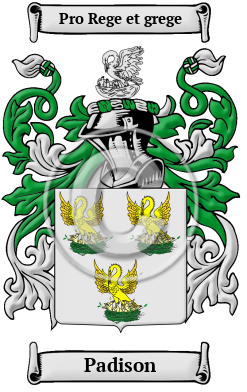| ![Show Contents]() Padison History, Family Crest & Coats of Arms Padison History, Family Crest & Coats of Arms
Etymology of PadisonWhat does the name Padison mean? The age-old Hebrides islands and the west coast of Scotland are the ancestral home of the Padison family. Their name comes from the personal name Patrick. Early Origins of the Padison familyThe surname Padison was first found in Ross-shire (Gaelic: Siorrachd Rois) a former county, now part of the Council Areas of Highland and Western Isles in Northern Scotland, which emerged from the Gaelic lordship of the Earl of Ross. The ancestral home of the Clan Pheadirean (Patersons) was on the north side of Lochfyne. Moving from the Gaelic into English spellings resulted in the typical wide range of surname spellings. By example, William Patrison and John Patonson, a 'gentillmen,' were witnesses in Aberdeen in 1446, Donald Patyrson was admitted burgess of Aberdeen in 1494, Robert Patersoun was 'capitane of ane were schip of Dundee' in 1544, Fyndlay Patersoun had a tack of the lands of Owar Elrik from the Abbey of Cupar in 1557, and so on. 1 Early History of the Padison familyThis web page shows only a small excerpt of our Padison research. Another 119 words (8 lines of text) covering the years 1604, 1632, 1658, 1679, 1691, 1700, 1706, 1708, 1719, 1727 and 1890 are included under the topic Early Padison History in all our PDF Extended History products and printed products wherever possible. Padison Spelling VariationsMedieval spelling was at best an intuitive process, and translation between Gaelic and English was no more effective. These factors caused an enormous number of spelling variations in Dalriadan names. In fact, it was not uncommon to see a father and son who spelled their name differently. Over the years, Padison has been spelled Patterson, Paterson, Pattersen, Patteson, Pattison and many more. Early Notables of the Padison familyJohn Paterson (1604-1679), Bishop of Ross; John Paterson (1632-1708), the last Archbishop of Glasgow, Bishop of Galloway, Bishop of Edinburgh; and William Pattison (1706-1727), an English poet.
Sir William Paterson (1658-1719), a Scottish trader and banker, one of the founders of the Bank of England. One story claims "he came from Scotland in his younger years, with a pack on...
Another 59 words (4 lines of text) are included under the topic Early Padison Notables in all our PDF Extended History products and printed products wherever possible. Migration of the Padison family to IrelandSome of the Padison family moved to Ireland, but this topic is not covered in this excerpt.
Another 75 words (5 lines of text) about their life in Ireland is included in all our PDF Extended History products and printed products wherever possible. Migration of the Padison familyScottish settlers arrived in many of the communities that became the backbones of the United States and Canada. Many stayed, but some headed west for the endless open country of the prairies. In the American War of Independence, many Scots who remained loyal to England re-settled in Canada as United Empire Loyalists. Scots across North America were able to recover much of their lost heritage in the 20th century as Clan societies and highland games sprang up across North America. Early immigration and passenger lists have documented some of the first Padisons to arrive on North American shores: Andrew and David Paterson who were banished to Georgia in 1685; James Paterson who settled in New Hampshire in 1718; David Patterson who settled in Boston in 1651.
The motto was originally a war cry or slogan. Mottoes first began to be shown with arms in the 14th and 15th centuries, but were not in general use until the 17th century. Thus the oldest coats of arms generally do not include a motto. Mottoes seldom form part of the grant of arms: Under most heraldic authorities, a motto is an optional component of the coat of arms, and can be added to or changed at will; many families have chosen not to display a motto.
Motto: Pro Rege et grege
Motto Translation: For King and people.
- Black, George F., The Surnames of Scotland Their Origin, Meaning and History. New York: New York Public Library, 1946. Print. (ISBN 0-87104-172-3)
 |

